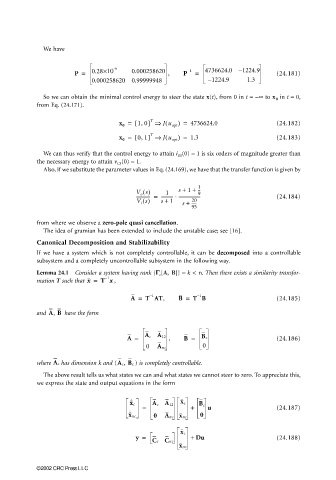Page 783 - The Mechatronics Handbook
P. 783
0066_Frame_C24 Page 31 Thursday, January 10, 2002 3:45 PM
We have
-6
P = 0.28×10 0.000258620 , P – 1 = 4736624.0 – 1224.9 (24.181)
0.000258620 0.99999948 – 1224.9 1.3
So we can obtain the minimal control energy to steer the state x(t), from 0 in t = −∞ to x 0 in t = 0,
from Eq. (24.171).
T
(
x 0 = [ 1, 0] ⇒ Ju opt ) = 4736624.0 (24.182)
(
x 0 = [ 0, 1] ⇒ Ju opt ) = 1.3 (24.183)
T
We can thus verify that the control energy to attain i R1 (0) = 1 is six orders of magnitude greater than
the necessary energy to attain v C3 (0) = 1.
Also, if we substitute the parameter values in Eq. (24.169), we have that the transfer function is given by
1
V o s() 1 s ++ 1 -- 9
------------ = ----------- ------------------- (24.184)
⋅
V i s() s + 1 20
s + -----
95
from where we observe a zero-pole quasi cancellation.
The idea of gramian has been extended to include the unstable case; see [16].
Canonical Decomposition and Stabilizability
If we have a system which is not completely controllable, it can be decomposed into a controllable
subsystem and a completely uncontrollable subsystem in the following way.
Lemma 24.1 Consider a system having rank {ΓΓ ΓΓ [A, B]} = k < n. Then there exists a similarity transfor-
c
mation T such that x = T – 1 , x
A = T AT, B = T B (24.185)
1
–
1
–
and A, B have the form
A = A c A 12 , B = B c (24.186)
0 A nc 0
where A c has dimension k and (A c, B c ) is completely controllable.
The above result tells us what states we can and what states we cannot steer to zero. To appreciate this,
we express the state and output equations in the form
˙ x c
= + u (24.187)
x c A c A 12 B c
˙ 0
x nc 0 A nc x nc
y = x c + Du (24.188)
Cc Cnc
x nc
©2002 CRC Press LLC

